|
|
|
The circles continued but after about 55 minutes I
saw color. Iím thinking this thing must be 100 pounds!
I had a fighting belt on but they are not all that handy when the fish youíre fighting
keeps moving behind you and to the left in circles. Finally I get it to within gaffing range, and
I take a shot. The gaff narrowly misses and somehow the line gets wrapped around the gaff hook!
|
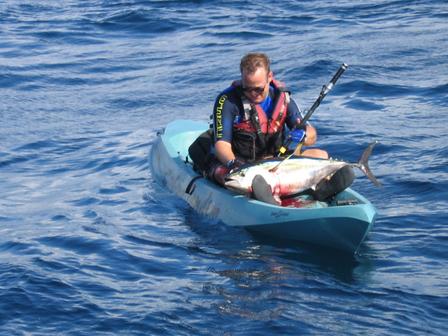
|
|
Possible major disaster! I carefully got it off and sank in the gaff, and put him up on my lap.
If youíve ever been on a tuna boat, you know how the fish make those rapid beating sounds on
the deck when they are dropped off of the gaff. Well, this one did those, except he did that as I
gave him a bear hug with gaff in his back. I wasnít about to let this guy beat his way to
freedom so I reached into his gills and did what I always do, which was to start ripping away at
the gills to induce blood loss. This calmed him down a bit, and then I proceeded to give him a
lobotomy with the gaff. Kurt was stoked and I was obviously elated to have had such early
success.
Interestingly enough, this was to be the largest
one I landed on the entire trip. Our initial guesstimates were about 50-60 pounds. After 7 hours
in the hot hold, it weighed out at 34#. Not bad. Probably a bit heavier when first boated so in
the future Iím going to take a scale. Actually after that fight I began to question just how
big a tuna I was capable of landing from a yak given their fighting habits, which seem to negate
most of the advantages that we usually gain on kayaks.
About 30 minutes later, trolling bait from my yak
again, I get a hit which absolutely scared me.
The reel was emptying so quickly that it looked like it was in a movie in time lapse
mode. I had never
|
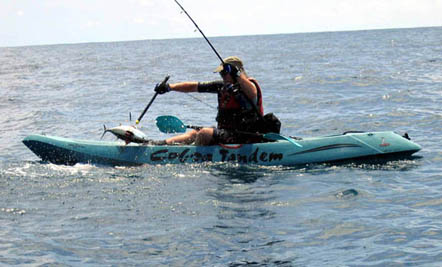 seen
that happen. By the time I got the stick out of the holder much of the line was gone and I
panicked and locked the drag down, which caused the line to snap. Whatever it was, it was huge
and this setup I was using was not going to be sufficient. seen
that happen. By the time I got the stick out of the holder much of the line was gone and I
panicked and locked the drag down, which caused the line to snap. Whatever it was, it was huge
and this setup I was using was not going to be sufficient.
Over the course of the day, the tuna started to
|
|
become more and more mobile, and every time Kurt would drop me off somewhere, theyíd be 200
yards away by the time I was paddling. I began to realize that I had been very fortunate earlier
on in the day. To reach the mobile tuna schools, we decided to have me use spinning gear with a
jig. I was able to head them off with the jig and got a whole bunch of 12-15 pounders this way,
which was fun on light tackle. Not that I had given up on the beasts. At one point, I took the
biggest setup in the whole boat, a trolling stick with a Penn Intl. 50 or 80 Wide!! It was way
too bulky but I had to try it.
|
|
The day ended up with me hooked up onto a large
fish again. I was on it for about 45 minutes and had gotten into that same stalemate, where my
arm was just incapable of applying enough pressure to lift the tip up enough to turn its head or
gain even a half a turn. At this point, the hook must have worn a big enough hole in the
tunaís jaw, and he came unbuttoned.
|
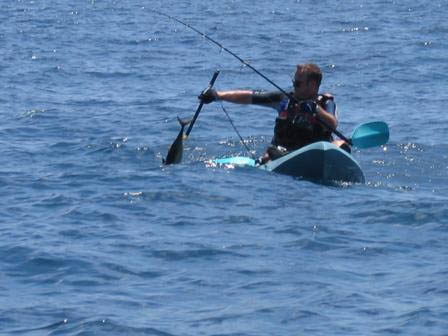
|
|
Lucky fish! Perhaps in the future when targeting these
fish I will use a 2 speed reel so that I can switch into a lower gear when a stalemate occurs.
I need to say that Kurt and I worked very well
together as a team, which I have found is absolutely key in this type of fishing. If youíre
going to be out in the middle of nowhere doing this, you really want someone that is thinking
about your safety and how to best accommodate your style, and Kurt did all of this. I really
lucked out with him and he saved the day, big time. He was totally
|
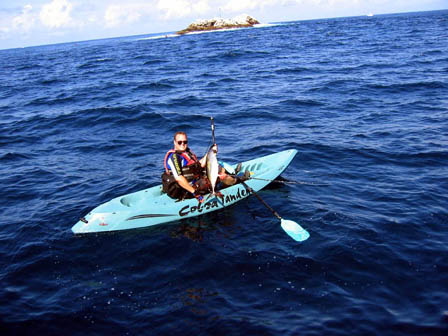 stoked the
whole day to be involved in this yak fishing thing and before we even made it back we were
planning our next adventure. stoked the
whole day to be involved in this yak fishing thing and before we even made it back we were
planning our next adventure.
The next day Tatís boat was ready, and he took me
out to the same area. I immediately got into a big fish, but this one dragged me right next to
the rocks. This was kind of scary because the sea was much choppier the
|
|
second day, and the waves
were crashing against the rocky outcropping. I didnít know what to do, so I let the fish have
just a bit of room to wiggle, hoping that heíd change direction. By this time I was about only
30 yards from where the waves were slapping against the rocks. Tat radioed me, saying that he was
sure that it was a huge pargo (they can get up to 70 pounds there), and not to give him too much
room, as he would just drag me to his cave and rock me. I thought I had the fish under enough
pressure to keep him up. It was on 40# test, on a TLD 20 2 speed, and I had the drag down pretty
tight, at least it seemed. Sure enough, he dragged me right to his house, and then surprised me
with a sudden burst downward, followed by a disheartening snap. Tricky fish, those pargos.
|
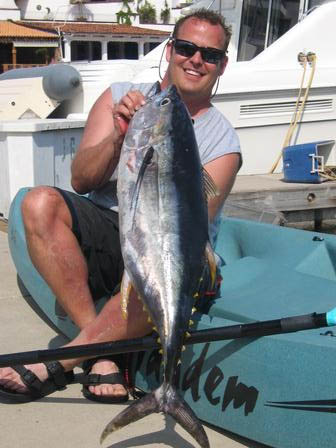 Giant tuna were jumping, and at least one boat landed a
150 # tuna, but I wanted to set a record and hook it from the yak, so even though I might have
been able to hook into one easier on the boat I kept trying from the yak.
Giant tuna were jumping, and at least one boat landed a
150 # tuna, but I wanted to set a record and hook it from the yak, so even though I might have
been able to hook into one easier on the boat I kept trying from the yak.
In hindsight, due to the chop and current on this day, and the fact that the tuna were all
over the place, this decision may have been based on an abundance of optimism, but I stuck to my stubborn plan. There were many moments when
the schools of big tuna passed right under me, and 10 pound skippies and 50-100 pounders were
jumping, but my skippy simply didnít get hit. What can ya do?
On a final note, I learned several things from this
trip. One, cruisers are not as good as pangas to go yak fishing with, as the pangas are more
maneuverable. When loading and unloading, especially in chop, it can get very hairy when a
cruiser is
|
|
bouncing up and down right next to you. Two, from now on when targeting large fish I
am going to set my drags to about 30% of line capacity, and leave it there. Up until this point
Iíd always fiddled with my drags, but drags set improperly on fish that take very long initial
runs can result in one getting spooled quickly, or broken off. Third, and finally, I am going to
show up with my own gear and be much more familiar with it. I want to be prepared for that next
moment that my setup gets a massive hit from a beast, should I be so fortunate once again.
|
|
|
|
<<previous
page
|